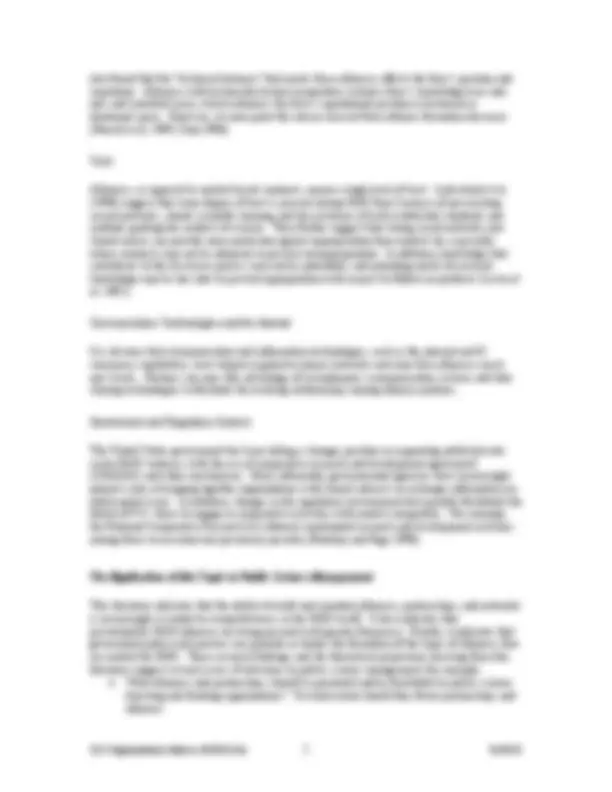






Study with the several resources on Docsity

Earn points by helping other students or get them with a premium plan


Prepare for your exams
Study with the several resources on Docsity

Earn points to download
Earn points by helping other students or get them with a premium plan
Community
Ask the community for help and clear up your study doubts
Discover the best universities in your country according to Docsity users
Free resources
Download our free guides on studying techniques, anxiety management strategies, and thesis advice from Docsity tutors
The growing trend of organizational alliances and partnerships in public sector organizations, focusing on research and development. The theoretical background of firms and markets, the blurring boundaries between them, and the current trends in organizational alliances and inter-firm networks. It highlights the motivators and facilitators of organizational alliances, including the need to form knowledge alliances, cope with competition, obtain complementary competencies, and manage uncertainty/risk. The document also discusses the implications for public science management, such as promoting alliances and partnerships among public sector organizations, with private sector r&d organizations, and with international partners.
Typology: Summaries
1 / 8

This page cannot be seen from the preview
Don't miss anything!





Although the literature on organizational alliances and networks focuses primarily on private sector organizations, public sector organizations have long confronted pressures to manage their environments through the formation of alliances. Moreover, several organizational theorists have posited that private and public sector alliances are becoming more prevalent, particularly in the realm of research and development (Eisenhardt and Schoonhoven 1996; Freeman 1991; Hagedoorn 1995). Public/private science and technology partnerships can help focus new research initiatives toward addressing collective and public issues, such as health, national security, and environmental protection. These partnerships also promote public and private cost sharing to achieve science goals and objectives. Finally, science partnerships could encourage more efficient and effective science, reducing redundancies, eliminating excessive and/or unproductive competition, and encouraging synergy and cooperation where needed. In addition, public science policy will have to address when, where, and how to promote scientific partnerships with developing countries and/or other international or global scientific alliances/partnerships.
Over a half century ago, Coase (1937) suggested that firms and markets represent alternative means of organizing business transactions– an insight that was largely ignored until Williamson (1975; 1985) elaborated its significance almost four decades later. Williamson presented a conceptual framework that contrasted the market and the hierarchical firm as the two main transaction modes. He placed little emphasis on transaction modes that fell in between these two poles. This market/hierarchical firm dichotomy dominated subsequent organizational thinking. Williamson’s core argument (1985:83) was that technical transactions will occur as market exchanges when they are straightforward, non-repetitive, and do not require transaction-specific investments; technical transactions will occur within hierarchically governed firms when they involve uncertainty about their outcome, recur frequently, and require substantial “transaction- specific investments” of money, time, or energy (meaning that they are not easily transferable). Williamson equated firms with hierarchies, assuming that all firms have hierarchical governance structures. Hierarchical firms basically come into existence because (1) it is difficult to specify clear contractual rights, obligations, and performance expectations for uncertain, repetitive, and asset-specific transactions; and (2) these types of transactions require strict monitoring and control to prevent the opportunism that could arise in the absence of strong hierarchical authority relations. Even though there are inefficiencies associated with hierarchical, bureaucratic organizations, organizations prefer these disadvantages to the relatively greater costs and risks that would occur if the transactions were conducted as market exchanges.
More recent scholars have challenged this market/hierarchy dichotomy. These challenges have been leveled on two fronts. First, the historical accuracy of the characterization has been attacked. Some argue that markets, in the modern sense of the term, did not exist until the latter
(^1) Related chapters include: Science Policy; Strategy; Change Management; Knowledge Management;
Teams, Projects, and Programs; Organizational Communication.
part of the eighteenth century. Early markets, such as those in medieval England, were steeped in personal, hierarchical, and symbolic underpinnings. Even after the rise of the modern market, craft-based firms in northern Italy and industries in southwestern Germany continued to be characterized by diversified, inter-firm linkages of suppliers, assemblers, and end users (Brusco 1982; Finley 1973; Herrigel 1990; Sabel 1989), and Japanese business groups even now continue to rely on extensive and flexible partnerships that promote joint learning and shared responsibility for technological innovation (Aoki 1990; Dore 1987; Fruin 1992; Sako 1992). The history of economic activity, whether told by Braudel (1982), Polanyi (1957), Thompson (1971), or Wallerstein (1974), is thus a story of enterprises characterized by loose and highly permeable boundaries, in contrast to firm/market dichotomies (Powell 1990).
Second, and most importantly, there is growing recognition that contemporary firms are increasingly blurring their boundaries by engaging in forms of collaboration that resemble neither the familiar “arm’s length” contracting arrangement of market exchanges nor the ideal hierarchical integration of the firm (Powell 1990). They are moving beyond hierarchical command and control governance structures and developing organizational contexts and support structures to facilitate internal and external exchanges and on-going relationships. The upsurge in non-hierarchical organizational forms challenges not only the accuracy of the market/hierarchy dichotomy, but also the power of this characterization as an explanatory device. Rather than treating non-hierarchical organizational forms as hybrids (Williamson 1991), theorists now see them as distinct organizational types that require a new explanatory frameworks. Several labels have been used to describe these organizational forms, such as virtual (Chesbrough and Teece 1996; Davidow and Malone 1992), network (Powell 1990), or flexible specialization (Piore and Sabel 1984). Whatever the label, these emerging organizations are attempting to govern economic exchanges in ways not captured by the market-hierarchy dichotomy.
For several decades, organizations have been placing greater priority on managing the external environment by building stronger relationships with customers and suppliers. These relationships can, but do not always reach the level of organizational partnerships. Recently, organizations have moved beyond customer/supplier relationships to begin to establish alliances with their competitors (Mariotti 1996). These inter-firm alliances typically take the form of formal organizational partnerships. Competitor alliances initially focused on specific joint product development efforts, but they are increasingly undertaking longer-term basic research and development (R&D) collaborations.
The expansion of organizational “partnerings” and other forms of external collaborations are especially pronounced in R&D intensive sectors, such as in the computer, semi-conductor, and biotech industries (Eisenhardt and Schoonhoven 1996; Freeman 1991; Hagedoorn 1995). As far back as the 1960s, computer firms said that IBM was not their competition but their environment (Porter 1985:7). IBM and GM were early leaders in forging organizational alliances that dramatically transformed their organizational boundaries. These companies now stand at the center of “vast, complicated, multinational confederations linking them to scores of other organizations” (Porter 1985:6). Alliance formation is now rampant throughout R&D-intensive industries, with the biotech industry taking the lead. Powell et al. (1996) found that network density within the biotech industry has increased dramatically in the last decade.
collaborate becomes greater for all organizations within that field and it becomes more difficult for organizations to survive as independent, isolated entities.
Small entrepreneurial firms, while conducive to innovation and new product development, often are not equipped to manage other requirements of business success. To enhance their competitiveness and survival, these small entrepreneurial companies frequently partner with venture capitalist firms as well as investors of all kinds. Increasingly, they are partnering with established corporations to gain business expertise and resources. For example, the hurdles experienced by new biotech companies in obtaining intellectual property rights from the Patent and Trade Office and product approval from the U.S. Food and Drug Administration have motivated them to form partnerships with large pharmaceutical corporations that have the experience to effectively manage these relationships (Powell et al. 1996).
Several decades ago, the resource dependency approach to organizational theory and research posited that firms facing uncertain environments would establish joint ventures as a means of reducing uncertainty and sharing the risk (Pfeffer and Novak 1976). Similarly, when sources of knowledge are diverse and the pathway of technological development is uncharted, alliances are expected to be most frequent (Powell et al. 1996). Early, as opposed to later, phases of R&D are most amenable to organizational alliances because uncertainty is higher and appropriation less of a threat at early stages of development (Leibeskind et al. 1996). Conversely, as research pursuits become more mature, firms may attempt to internalize all the essential expertise as a strategy to protect against misappropriation (Levin et al. 1987).
When exchanges occur through social networks, the costs of contracting are reduced or eliminated, exit barriers are more easily avoided, and firms can more readily develop alliances with different partners as needed (Leibeskind et al. 1996). In addition, Uzzi (1997) found that embeddedness in organizational networks promotes adaptation because firms are less subject to short-term pressures and shocks. Organizations use their organizational networks to pool resources, pursue longer-term strategies, help out exchange partners when needed, and inform one another of work shortages and fluctuations. Social networks provide an important resource for firms and alliances and partnerships can provide a strategic advantage.
Stuart (1998) notes that many of the motivating factors identified in the literature do not really explain whether and when collaborations will occur or among which organizations. He suggests that industry crowding and organizational reputation are important factors determining a firm’s opportunity to form collaborations. However, as Powell et al. (1996) and Stuart and Podolny (1999) note, an organization’s reputation is in some sense a product of its alliances. In general, the greater the number of alliances, the better the firm’s reputation. Stuart and Podolny (1999)
also found that the “technical distance” that marks these alliances affects the firm’s position and reputation. Alliances with technically distant competitors extend a firm’s knowledge base into new and unrelated areas, which enhances the firm’s reputational position in technical or ideational space. However, at some point the returns derived from alliance formation decrease (Powell et al. 1999; Uzzi 1996).
Alliances, as opposed to market-based contracts, require a high level of trust. Leibeskind et al. (1996) suggest that some degree of trust is present among R&D firms because of pre-existing social networks, shared scientific training, and the existence of well-established standards and methods guiding the conduct of science. They further suggest that strong social networks and shared norms can provide more protection against appropriation than markets do, especially where contracts may not be adequate to prevent misappropriation. In addition, knowledge that contributes to the discovery process may not be patentable, and patenting newly discovered knowledge may be too slow to prevent appropriation with respect to follow-on products (Levin et al. 1987).
It is obvious that communication and information technologies, such as the internet and E- commerce capabilities, have helped supplier/customer networks and inter-firm alliances reach new levels. Partners can now take advantage of instantaneous communication systems and data sharing technologies to facilitate the working relationships among alliance partners.
The United States government has been taking a stronger position in supporting public/private sector R&D ventures, with the use of cooperative research and development agreements (CRADAS) and other mechanisms. More informally, governmental agencies have increasingly played a role in bringing together organizations with shared interests to exchange information on public good issues. In addition, changes in the regulatory environment have greatly facilitated the ability of U.S. firms to engage in cooperative activities with market competitors. For example, the National Cooperative Research Act allowed coordinated research and development activities among firms to an extent not previously possible (Podolny and Page 1998).
This literature indicates that the ability to build and maintain alliances, partnerships, and networks is increasingly essential to competitiveness in the R&D world. It also indicates that private/public R&D alliances are being pursued with greater frequency. Finally, it indicates that government policy and practice can promote or hinder the formation of the types of alliances that are needed for R&D. These research findings and the theoretical projections deriving from this literature suggest several issues of relevance to public science management, for example: ♦ What alliances and partnerships should be promoted and/or facilitated by public science directing and funding organizations? To what extent should they foster partnerships and alliances
Aoki, Masahiko. 1990. Toward an Economic Model of the Japanese Firm. Journal of Economic Literature 28:1-27.
Braudel, F. 1982. The Wheels of Commerce. New York: Harper Row.
Badaracco, Joseph L. Jr. 1991. The Knowledge Link: How Firms Compete through Strategic Alliances. Boston: Harvard Business School Press.
Brusco, S. 1982. The Emilian Model: Productive Decentralization and Social Integration. Cambridge Journal of Economics 6:167-184.
Chesbrough H. and D. J. Teece. 1996. When is Virtual Virtuous: Organizing for Innovation_. Harvard Business Review_ 74 (1):65-73.
Coase, R. 1937. The Nature of the Firm. Economica 4:386-405.
Davidow, W.H. and M.S. Malone. 1992. The Virtual Corporation. New York: Harper Collins.
Deeds, David and Charles Hill. Strategic Alliances and the Rate of New Product Development: An Empirical Study of Entrepreneurial Biotechnology Firms. Journal of Business Venturing 11:41-55.
Dore, Ronald. 1987. Taking Japan Seriously. Stanford: Stanford University Press.
Eisenhardt, Kathleen M. and Claudia Bird Schoonhoven. 1996. Resource-based View of Strategic Alliance Formation: Strategic and Social Effects in Entrepreneurial Firms. Organization Science 7:136-150.
Finley, M. 1973. The Ancient Economy. Berkeley: University of California Press.
Freeman, Christopher. 1991. Networks of Innovators: A Synthesis. Research Policy 20:499-
Fruin, Mark W. 1992. The Japanese Enterprise System. New York: Oxford University Press.
Hagedoorn, John. 1995. Strategic Technology Partnering during the 1980s: Trends, Networks, and Corporate Patterns in Non-Core Technologies. Research Policy 24:207-231.
Herrigel, Gary. 1990. Industrial Organization and the Politics of Industry: Centralized and Decentralized Production in Germany. Cambridge, MA: MIT, Department of Political Science, Ph.D. thesis.
Jordan, G.B., L.D. Streit, and J.S. Binkley. 1999. A Framework for Assessing the Effectiveness of Research Organizations. Albuquerque, NM: Sandia National Laboratories.
Levin, R., R. Klevorick, R. Nelson, and S. Winter. 1987. Appropriating the Returns from Individual Research and Development. Brookings Papers on Economic Activity (3).
Liebeskind, Julia, Amalya Oliver, Lynne Zucker, and Marilynn Brewer. 1996. Social Networks, Learning, and Flexibility: Sourcing Scientific Knowledge in New Biotechnology Firms. Organization Science 4:428-443.
Mariotti, John. 1996. The Power of Partnerships: The Next Step Beyond TQM, Reengineering, and Lean Production. Cambridge: Blackwell Business.
Pfeffer, J. and P. Nowak. 1976. Joint-Ventures and Interorganizational Interdependence. Administrative Science Quarterly 21:398-418.
Piore, Michael and Charles Sabel. 1984. The Second Industrial Divide. New York: Basic Books.
Podolny, Joel and Karen Page. 1998. Network Forms of Organization. Annual Reviews Sociology 24:77-103.
Polanyi, Karl. 1957. The Great Transformation. Boston: Beacon Press.
Porter, Michael E. 1985. Competitive Advantage: Creating and Sustaining Superior Performance. New York: The Free Press.
Powell, Walter W. 1996. Inter-Organizational Collaboration in the Biotechnology Industry. Journal of Institutional and Theoretical Economics (JITE) 152:197-152.
Powell, Walter W. 1990. Neither Market nor Hierarchy: Network Forms of Organization. Research in Organizational Behavior 12:295-336.
Powell, Walter W. 1998. Learning from Collaboration: Knowledge and Networks in the Biotechnology and Pharmaceutical Industries. California Management Review 40:228-240.
Powell, Walter W., Kenneth W. Koput, and Laurel Smith-Doerr. 1996. Interorganizational Collaboration and the Locus of Innovation: Networks of Learning in Biotechnology. Administrative Science Quarterly 41:116-145.
Powell, Walter W., Kenneth W. Koput, Laurel Smith-Doerr, and Jason Owen-Smith. 1999. Network Position and Firm Performance: Organizational Returns to Collaboration in the Biotechnology Industry. Research in the Sociology of Organizations 16:129-159.
Sabel, Charles. 1989. Flexible Specialisation and the Re-Emergence of Regional Economies. In Reversing Industrial Decline? Hirst and Zeitlin (eds.). London: Berg.
Sako, Mari. 1992. Prices, Quality and Trust: Inter-Firm Relations in Britain and Japan. Cambridge: Cambridge University Press.
Stuart, Toby E. 1998. Network Positions and Propensities to Collaborate: An Investigation of Strategic Alliance Formation in a High-technology Industry. Administrative Science Quarterly 43:668-698.
Stuart, Toby E. and Joel M. Podolny. 1999. Positional Consequences of Strategic Alliances in the Semiconductor Industry. Research in the Sociology of Organizations 16:161-182.
Thompson, E.P. 1971. The Moral Economy of the English Crowd in the Eighteenth Century. Past and Present 50:78-98.
Uzzi, Brian. 1996. The Sources and Consequences of Embeddedness for the Economic Performance of Organizations: The Network Effect. American Sociological Review 61:674-
Uzzi, Brian. 1997. Social Structure and Competition in Interfirm Networks: The Paradox of Embeddedness. Administrative Science Quarterly 42:35-67.
Wallerstein, Immanuel. 1974. The Modern World System I. New York: Academic Press.
Williamson, O.E. 1975. Markets and Hierarchies. New York: Free Press.
Williamson, O.E. 1985. The Economic Institutions of Capitalism. New York: Free Press.
Williamson, O.E. 1991. Comparative Economic Organization: The Analysis of Discrete Structural Alternatives. Administrative Science Quarterly 36:269-296.